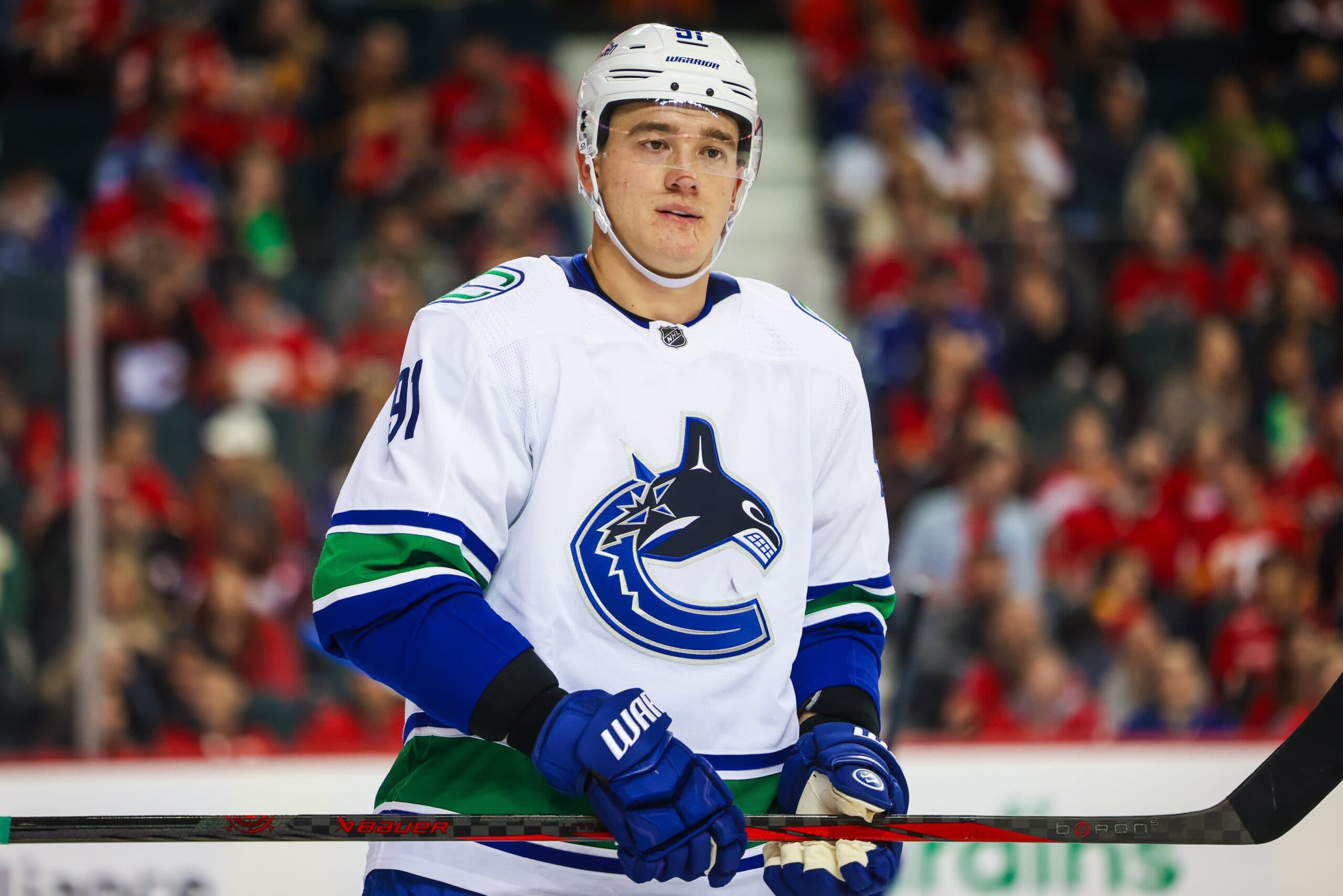The Boston Bruins’ recent focus on adding size and physicality to their roster signifies a strategic shift towards a “bigger is better” philosophy. This approach is especially evident with the acquisition of 6-foot-6 defenseman Nikita Zadorov, known for his punishing style of play. Zadorov’s presence on the ice is expected to enhance the team’s defensive prowess, creating an intimidating atmosphere for opponents attempting to penetrate the Bruins’ zone.

In today’s NHL, where the emphasis has shifted towards speed and skill, the Bruins’ strategy reflects a blend of traditional and modern hockey values. By incorporating physical players like Zadorov, the Bruins aim to counterbalance the speed and finesse of their competitors with strength and toughness. This move underscores the importance of having a versatile roster capable of adapting to various styles of play, highlighting the ongoing evolution of team-building strategies in professional hockey.
I’m very much looking forward to seeing this side of Zadorov on the Bruins. Love his physicality. It’ll be nice to watch a Bruins defender stand up for their tendy#NHLBruins pic.twitter.com/cVLERUOtfA
— OnlyBruins (@OnlyBruinsPod) July 1, 2024
Don Sweeney, the General Manager of the Boston Bruins, highlighted the importance of Nikita Zadorov’s presence on the team. He emphasized Zadorov’s growth as a player, noting his extensive experience playing top-four minutes in the playoffs against elite opponents. This experience has helped Zadorov refine his game and gain confidence in his abilities. Sweeney acknowledged that early in Zadorov’s career, his aggressive style sometimes resulted in mistakes, but he has since matured and understands his role better.
Zadorov’s excitement about joining the Bruins is evident, particularly with the potential opportunity to play alongside Charlie McAvoy, one of the league’s top defensemen. This enthusiasm was a significant factor in the Bruins’ decision to bring him in. Zadorov’s interest in Boston was driven by the right reasons, which aligns with the team’s goals and values.
The Bruins’ defensive lineup for the upcoming season showcases a notable emphasis on size and physicality. Among the six defensemen expected to start, Charlie McAvoy is now the smallest at 6-foot-1 and 209 pounds. None of the other defensemen are shorter than 6-foot-3 or weigh less than 210 pounds, underscoring the team’s commitment to a robust and imposing defensive corps. This strategic shift aims to balance the modern game’s speed and skill with a strong, intimidating presence on the back end.
Nikita Zadorov is now the biggest and most intimidating player on the Bruins roster at 6-foot-6 and 248 pounds. Despite his formidable presence, Zadorov is quick to distance himself from the “Big Z” nickname, which was famously associated with Zdeno Chara during his Hall of Fame-worthy tenure with the team.
Zadorov expressed his respect for Chara and his accomplishments, acknowledging that he doesn’t see himself on the same level. “I mean, it’s hard. I’m not even close [to Zdeno Chara], and I want to start with I know in my past, teams and people were calling me ‘Big Z.’ Please do not ever call me ‘Big Z’ now because I mean, I feel like I’m not even close to half of the ‘Big Zee,'” said Zadorov. “He was unbelievable. He’s one of the best defensemen of all time. There’s definitely a lot to learn from him.”
He further shared that Chara was one of his role models growing up, admiring his size, physical play, and leadership qualities. Zadorov hopes to emulate and learn from Chara’s example, underscoring the respect and humility he brings to his new role with the Bruins.
🎥 Nikita Zadorov on joining the #NHLBruins: "Where do I start about why did I choose the Bruins? Everything…it's a big league, everybody talks…haven't heard a bad thing in 11 years about the Bruins culture."
Watch full media availability ➡️ https://t.co/DbwRo60KlX pic.twitter.com/kCJJnecvgB
— Boston Bruins (@NHLBruins) July 1, 2024
The addition of players like Nikita Zadorov, along with Brandon Carlo and Andrew Peeke, signifies a return to the traditional, hard-hitting identity of the Boston Bruins. These players bring size, physicality, and toughness to the team, which helps alleviate some of the pressure on Charlie McAvoy to always be the primary physical presence on the blue line.
With Zadorov joining the Bruins, there’s an opportunity for McAvoy to concentrate more on his strengths, such as puck movement and offensive creativity. Additionally, pairing McAvoy with a player like Zadorov could potentially shield him from some of the physical punishment he often faces as a top defenseman. This partnership not only balances the defensive responsibilities but also enhances the team’s overall defensive stability and intimidation factor.
By integrating these players into the lineup, the Bruins are aiming to maintain a blend of modern skill and traditional toughness, ensuring they remain competitive in a league that values both speed and physicality.
In today’s NHL, the importance of having a formidable defensive corps cannot be overstated, and size plays a significant role in that equation. Teams often look to build a roster that includes tall, physically imposing defensemen to compete effectively throughout the season and ultimately contend for the Stanley Cup.
The rationale behind this strategy is multifaceted. Firstly, taller defensemen typically have longer reaches, which can be crucial in disrupting plays, blocking shots, and defending against skilled opponents. Their size also adds a physical element that can wear down opposing forwards over the course of a game or a playoff series.
Moreover, in the fast-paced, high-intensity playoff environment, larger defensemen are often better equipped to handle the physical demands and endure the rigors of extended postseason play. Their presence in front of the net can make it difficult for opponents to establish position and screen the goaltender, which is crucial in playoff scenarios where every goal matters.
While skill and speed remain vital components of successful NHL teams, the presence of “tall trees” on the back end provides a strategic advantage that many teams recognize and actively seek to cultivate. This approach aligns with the evolving dynamics of the game while acknowledging the enduring importance of size and physicality in championship-caliber teams.
Really interesting look from @JasonGregor at the common thread from the last 20 #StanleyCup finalists: Their defensemen averaged 6-foot-2 and 219 pounds. https://t.co/ZcxCo2uC3f
— Frank Seravalli (@frank_seravalli) June 15, 2021
Nikita Zadorov understands the importance of his role on the Boston Bruins goes beyond just delivering big hits and physically dominating opponents around the net, although that aspect of his game is certainly notable. In today’s NHL, where the playoffs often intensify physical battles and net-front presence becomes crucial, having defensemen like Zadorov, Mason Lohrei, and Hampus Lindholm—big-bodied players who are also skilled puck movers—is increasingly valuable.
These players bring a combination of size, strength, and defensive awareness that can effectively neutralize opponents in critical playoff situations. They are less likely to be overpowered around the net compared to smaller defensemen, which has been a vulnerability for some teams in past postseasons.
However, Zadorov recognizes that his responsibilities extend beyond physical play. While he excels in providing a physical presence, he also understands the importance of sound positional play, effective puck management, and contributing to the team’s overall defensive structure. This well-rounded approach ensures that he remains a valuable asset to the Bruins, contributing not only through physicality but also through disciplined and strategic defensive contributions.
In essence, while the NHL continues to evolve with an emphasis on speed and skill, the presence of robust defensemen who can handle the physical demands of playoff hockey remains a crucial element for teams aspiring to championship success.
Nikita Zadorov reflects on how the NHL has evolved during his career, noting a shift towards smaller, faster, and more skilled defensemen. Despite this trend, Zadorov emphasizes that his game is rooted in physicality and being difficult to play against. Defense remains his primary focus, but he also acknowledges his ability to contribute offensively when needed, even though he doesn’t consider himself a prolific goal scorer.
He recognizes that development as a defenseman in the NHL can be a gradual process, and he feels he has been steadily improving each year. This improvement encompasses not only his physical play but also his overall game and understanding of his role within a team’s defensive structure.
Zadorov’s comments underscore a crucial point about the modern NHL landscape: while smaller defensemen can excel in the regular season due to their speed and puck-moving abilities, playoff success often requires a different approach. Teams with bigger, heavier, and more physically imposing defensemen tend to fare better in the playoffs, where the game becomes more physical and net-front battles intensify.
In essence, while the league continues to favor speed and skill, there remains a significant role for defensemen who can leverage their size and strength effectively, especially in the demanding environment of playoff hockey. This balance between skill and physicality is a key consideration for teams aiming to compete for the ultimate prize, the Stanley Cup.
It’s unfortunate that it became his last play in a Boston Bruins uniform, but is there any doubt John Tavares recognized he had an undersized Matt Grzelcyk covering him when he bull-rushed the net to set up this overtime playoff game-winner for the Maple Leafs?
KNIES OT WINNER in GAME 5 vs Bruins courtesy of @Bonsie1951 and @Jim_Ralph. @LeafsJelly pic.twitter.com/GvBdBRyLCF
— Maple Leafs Hotstove (@LeafsNews) May 1, 2024
The postseason in hockey is a time when any weaknesses in a team’s lineup can be ruthlessly exploited by opponents who are skilled and opportunistic. In the case of the Boston Bruins, there have been instances where decisions surrounding smaller defensemen have had significant implications.
For example, Matt Grzelcyk, known for his puck-moving ability and skill, did not play in the later stages of the recent postseason despite the Bruins advancing to the second round. This highlights how teams can sometimes adjust their lineup preferences based on playoff matchups and the physical demands of postseason hockey.
Similarly, a few years ago, the Bruins faced a decision with Torey Krug, another smaller defenseman known for his offensive contributions. When the Bruins opted not to match the lucrative contract offered by the St. Louis Blues, Krug moved on, eventually winning the Stanley Cup with the Blues before they sought to trade his contract a couple of years later.
These scenarios underscore the strategic balancing act NHL teams must navigate between skill and size, especially when it comes to the postseason. While smaller defensemen can excel with their speed and offensive abilities during the regular season, teams often prioritize larger, more physically imposing defensemen for playoff success. The decisions surrounding players like Grzelcyk and Krug illustrate how these dynamics play out in roster management and the long-term financial considerations that teams face.
Ultimately, the NHL playoffs serve as a proving ground where teams must maximize their strengths and address any potential vulnerabilities to compete effectively for the championship.
The departure of Torey Krug from the Boston Bruins left a void in terms of dynamic offensive production, particularly on the power play. While Krug’s offensive prowess was evident, there were also instances in past playoffs where his smaller stature posed challenges defensively against larger opponents.
The acquisition of Nikita Zadorov addresses some of these concerns directly. Zadorov’s size, strength, and physicality add a new dimension to the Bruins’ defensive lineup, making them unquestionably bigger, stronger, and meaner. This complements the existing core of defensemen like Charlie McAvoy, Hampus Lindholm, Brandon Carlo, and emerging talent Mason Lohrei, who are all capable of playing significant roles in the top four.
General Manager Don Sweeney emphasizes the strength of their defensive depth, viewing it as a cornerstone of the team. He believes this group has the potential to contribute more offensively while maintaining a solid defensive presence. This depth is crucial not only for supporting the development of younger players like Lohrei but also for enabling McAvoy and Lindholm to excel at their respective levels.
In summary, the Bruins’ strategic approach to bolstering their defensive core with players like Zadorov reflects a commitment to balancing defensive solidity with the ability to generate offense. This mix of size, skill, and depth is essential for competing at a high level in the NHL, particularly during the demanding playoff matchups where defensive resilience and offensive contributions are equally critical.
The addition of Nikita Zadorov to the Boston Bruins’ defensive lineup is seen as a significant upgrade that enhances the team’s depth and versatility. Zadorov’s ability to handle substantial ice time, potentially logging around 20 minutes per game, contributes to a more balanced distribution of defensive responsibilities among the Bruins’ lineup.
While much attention has understandably been on the signing of Elias Lindholm to address center position needs, Zadorov’s impact should not be underestimated. His size, physicality, and defensive prowess bring a crucial element to the Bruins’ defensive corps, particularly in the context of the regular season grind and the intensified physicality of the Stanley Cup playoffs.
In the postseason especially, where physical battles and net-front presence often determine success, Zadorov’s presence adds a layer of toughness that can help the Bruins compete more effectively against formidable opponents. His ability to intimidate opponents and provide stability in the defensive zone complements the team’s offensive firepower and overall defensive strategy.
In essence, while Lindholm’s signing addresses a key need at center, Zadorov’s addition fortifies the Bruins’ defensive backbone in a manner that can significantly bolster their playoff aspirations. His impact is expected to extend beyond just the regular season, making the Bruins a more formidable contender in pursuit of hockey’s ultimate prize, the Stanley Cup.



